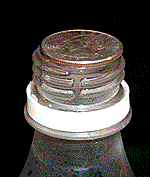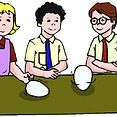Welcome to
Formby Bubble
Love Your Community - Love Your Bubble
We would love to hear about your science experiments, if we like them we might put them on this page with your name on it.
Email us with your experiments to:
Welcome to Science

Tornado in a Bottle
What You Need:
o Two 2 litre bottles
o Tape (duct tape works best)
o Water
o Food colouring (optional)
Instructions:
1. Fill one of the bottles about 3/4 full of water. Add a drop or two of food colouring.
2. Put the empty bottle upside-down on top of the bottle filled with water.
3. Tape the mouthpieces together.
4. Flip the bottles over so the one filled with water is on top. Rotate the bottle on top in a circular motion until a tornado starts to form.
5. Set the bottles on the table and watch the tornado in action!
6. Have fun!

Try this experiment to make your own fog
London Fog – Anywhere You Want It!
What You Need:
o A large jar
o Water
o Strainer
o Ice cubes
Instructions:
1. Fill the jar with hot water.
2. Pour out all the water except for about an inch.
3. Place the strainer over the mouth of the jar, and put a few ice cubes in it.
4. The cold air from the ice cubes will cause the water to condense from the warm, moist air in the bottle, and an eerie fog will form.
Did you know water can grow?
What You Need:
o Small plastic bottle
o Water and foil
Instructions:
1. Fill the bottle to the brim with water.
2. Place a loose piece of aluminium foil over the bottle.
3. Put the bottle in the freezer and leave it inside until the water has frozen completely.
4. After the water has frozen, notice how the ice has pushed up the foil, and maybe even pushed at the sides of the bottle.
Why?
Water occupies less space than ice, so when the ice froze, it needed more space than was available in the bottle, and pushed up the foil cover.
Did you know that you can make a coin move without touching it?
Clickety-Clackety Coin
What You Need:
o 2-liter plastic soda bottle
o A quarter
o Water
Instructions:
1. Place the empty uncapped bottle in the freezer for 10 minutes.
2. Dip the coin in water.
3. Remove the bottle from the freezer and immediately place the wet coin on the top of the open bottle.
4. Wait and watch the coin move! As it moves, it will make a clickety-clackety noise.
Note:
When removed from the freezer, the cold air inside the bottle expands and tries to rush out of the bottle. This air flow causes the coin to move!
Make a Rainbow
What You Need:
o A glass of water
o A sheet of white paper
o A sunny day or a flashlight
Instructions:
1. Fill the glass almost to the top with water.
2. If you are using sunlight, place the glass so that it is half on and half off the edge of a table, and so that the sun shines directly through the water, onto a sheet of white paper on the floor.
3. Adjust the paper and the glass until a rainbow forms on the paper.
4. If you are using a flashlight, place the glass of water on the white piece of paper, and move the flashlight around until you see a rainbow on the piece of paper
Why?
Light is made up of many colours, and when it passes through water, it is broken up into the other colours seen in a rainbow.
The rainbow in this picture was made with a flashlight, and can be seen near the bottom of the glass. It was not a very big rainbow, but once the flashlight was placed just right, there it was!
Ringing Fork
What You Need:
o 3 foot length of string or thread
o Fork
Instructions:
1. Tie the fork to the center of the string.
2. Tie one end of the string around your right index finger, and tie the other end around your left index finger.
3. Touch your fingers to your ears and let the fork hang in front of you.
4. Have a friend tap the fork with a spoon and you’ll hear a loud ringing in your ears! The sound has traveled up the string to your ears.
Tip:
Try tying other metal objects to the string and see what sounds they make.
Raw or Cooked?
What You Need:
o One cooked egg
o One raw egg
Instructions:
1. Spin each egg in turn on a plate. The egg that continues to spin for a longer time is the cooked one.
2. Now spin the eggs again, then quickly stop both of them. Then let go of both eggs. You will see that the cooked egg stays still but the raw one starts spinning again.
Why?
The contents of the egg have more inertia when they are raw, because they are in the form of a liquid. This inertia slows down the raw egg and that is why it stopped spinning before the cooked egg. In step 2, the liquid in the raw egg was still moving when you stopped both eggs, so that movement made the raw egg begin to spin again.

Colour a Flower
What You Need:
o White flowers
o Vase of water
o Food coloring
Instructions:
1. Put a white carnation or daisy in a vase with 1/2 cup of water.
2. Mix 10 or more drops of food coloring into the water.
3. Leave the flower overnight, and you’ll see the petals change colors. If you leave the flower in the colored water longer, more color will fill the petals.
The food coloring travels up through the stem by capillary action and leaks into the flower’s petals. If you look closely at the petals you can see the path that the food color and water travel.
I guess that proves the saying “You are what you eat!”
___________________________________________________________
Use this Forum to tell us your views about anything you want to do with parents and kids or anything on our site, whatever you want....
Advertise Here




























